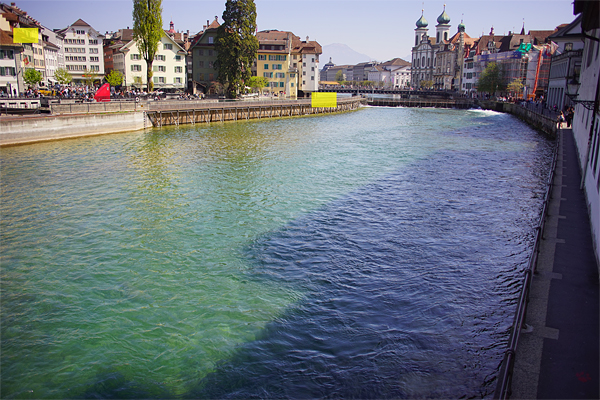For decades, the 28mm wideangles were most popular. Between 1963 and 1983, Minolta has been introducing eight optical computations with four different speeds (f2, f2.5, f2.8 and f3.5) in about 25 versions only for ist SR-System - starting with a bulky 3.5/28mm in 1963 and ending with a small, excellent 2/28mm in 1983.
I have tested all eight relevant optical formulas. The results are given below.
Lenses: Minolta MC-I 3.5/28mm [7/7, 67mm filter thread], MC-X 3.5/28mm [7/7, 55mm filter], MC-X 2.5/28mm [9/7], MC-X 2/28mm [10/9, floating focusing], MD-II 2.8/28mm [7/7], MD-II 3.5/28mm [5/5], MD-III 2.8/28mm [5/5], MD-III 2/28mm [9/9, floating focusing]
Camera: Sony Alpha 7
Tripod: Giotto Carbon Fiber MT 8240B
Head: Manfrotto 410
Focusing: manually on the yellow spot near the center (see image below), using the widest aperture. No re-focusing when stopping down.
The first 28 mm lens for the Minolta SR system was introduced in 1963. Its optical formula has remained unchanged when the lens barrel was modified to the "meter coupling" (MC) version in 1966. Its size is comparable to later 2.8/20mm lenses such as the Nikkor AiS or the Canon FD. Wide open, the entire image is quite soft, but the details are there. At f11 the image is crisp and clear, and CAs are well controlled. In 1963 it was probably one of the better 28mm retrofocus lenses.
The second computation of the 3.5/28mm [7/7] was much smaller than its precedessor. It was introduced in 1968, with the same "MC-I" type barrel as shown above. Later the same optical formula came in MC-II (1970) and MC-X mounts (1973; shown here). I have tested all three flavours, and their performance is identical. When "Modern Photography" checked the performance of MC-X lens series in 1974, the results of the MC 3.5/28mm were a bit disappointing.
Distortion, however, is very low at 0.5% only!
The above MC-X 3.5/28mm [7/7] was replaced in 1975. The "new" 3.5/28mm - still in MC-X mount - has only five lenses in five groups.
The MC 2.5/28mm was the fasted 28mm SLR lens in 1968. It comes in three versions as well: MC-I (1969), MC-II (1970) and MC-X (1973). All versions share the same optical formula which includes one radioactive thoriated lens. The radioactivity causes a distinctive yellowish color cast which can be cured by exposing the back of the lens to UV light. The coatings of the three versions, however, are different.
The MC 2.5/28mm was always considered as the better lens than the [7/7] 3.5/28mm. Detail resolution is OK even at f2.5, but large parts of the image suffer from coma and astigmatism which really clears up only at f11. The color correction is quite good, and distortion is low (1% barrel).
The lens barrel itself is exquisitely finished; focusing is extremely smooth and precise - comparable to the best of Leica.
I have tested all three versions (MC-I, MC-II, MC-X); they have identical resolution and contrast even though their coating seems to be slightyl different.
In 1975 the thoriated glass of the MC 2.5/28mm had becom obsolete; a new, faster 2/28mm with floating elements hit the market. The optical formula was produced in MC-X (1975, shown here), MD-I (1977) and MD-II (1978) mounts. The MC-X version behaves similar to the MC 2.5/28mm, apart from the yellowing thorium glass, which obviously is missing. A bit more CAs maybe, and a bit more resolution at f5.6, but generally quite similar to the 2.5/28mm ...
In 1975 the ageing [7/7] 3.5/28mm was replaced by a small, simplified [5/5] construction. Nevertheless the new lens is much better than the [7/7] formula. Large parts of the image are perfect at f3.5, and only the corners suffer a bit from lower contrast. Center resolution peaks arounf f5.6; the corners have lots of detail. CAs are visible, but can easily be removed using suitable software. The small and lightweight lens is a good match to the Sony A7 if speed is not essential.
I have tested the MC-X, MD-I and MD-II versions - they give identical images on the 24 MP FF sensor.
The Minolta MC-X 2.8/28mm was introduced in 1975. Its [7/7] optical formula remained unchanged while its barrel was upgraded to MD-I (1977), MD-II (1978, much smaller; see image above) and MD-III (1981). Be aware that not all MD-III versions are of the [7/7] formula; the later MD-III 2.8/28mm are a [5/5] construction with lower resolution.
The [7/7] Rokkor 2.8/28mm is a workhorse. It was produced in large quantities, and its performance is impeccable. While there may be a bit more coma and astigmatism wide open, the lens performs otherwise very similar to its [5/5] 3.5/28mm counterpart.
I have tested the MC-X, MC-I and MC-II versions with identical results.
In 1983 the [7/7] MD-III was replaced by a simplyfied [5/5] version. While on APS-C the [5/5] is as good as the [7/7], it can't compete with it on full frame. It's angle of view is a bit smaller, thus reducing the difficulties for the lens designer. Both versions look nearly identical from outside.
Finally the last 28mm prime for the Minolta SR system! Its 1983 now, and new Minolta AF system (1985) is looming on the horizon. The lens is small, lightweight (265g), fast and ... sharp! Even though fast wideangles are difficult to construct, this 2/28mm outperforms all other Minolta MC/MD 28mm lenses. The lens has floating focusing, realtively modern coatings, and 49mm filter thread. Focusing is - compared to the extraordinary silky feeling of the MC-X 2.5/28mm - quite "stiff".
The computation of the MD-III 2/28mm was later taken into the Minolta AF system.
I have tested two samples of the MD-III and two samples of the AF; their performance is identical.










